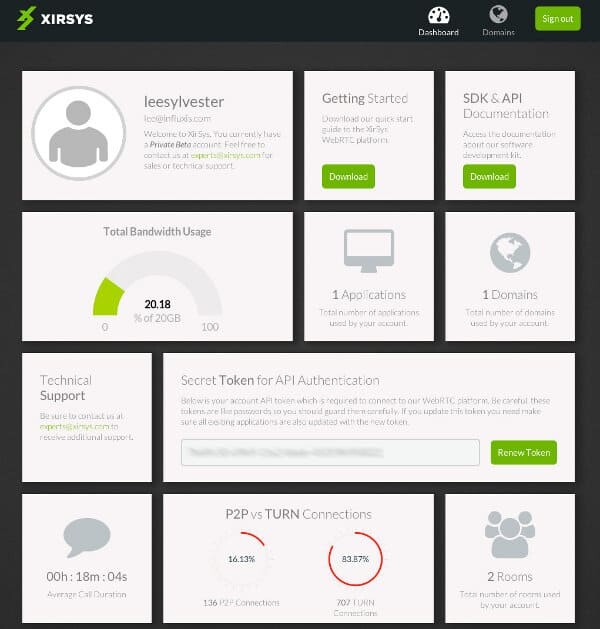If you are contemplating how to deploy NAT traversal with WebRTC, then how about “outsourcing” it to someone like XirSys?
WebRTC is missing an infrastructure, and there, vendors are providing the tools and means to close the gap. Some of these vendors offer on-premise solutions that you license and install while others go for hosted services.
From my talks with vendors who start out with WebRTC, it seems like some of them haven’t yet gotten to deploying TURN at all. I guess it is a headache to deal with. There’s now a simple and hosted solution for that – XirSys.
 When I met Richard Blakely, CEO of XirSys, at the last WebRTC event in Atlanta, I knew this is a story I wanted to share here. Richard was kind enough to answer my questions.
When I met Richard Blakely, CEO of XirSys, at the last WebRTC event in Atlanta, I knew this is a story I wanted to share here. Richard was kind enough to answer my questions.
What is XirSys all about?
XirSys is an Infrastructure as a Platform for WebRTC enabled services and applications. We handle the messaging necessary to establish a Peer-2-Peer or TURN connection and provide the tools for businesses to get up and running quickly. We also work closely with companies to ensure their infrastructure works as expected, and is reliable and scalable.
What excites you about working in WebRTC?
It is what has always excited me most about the Internet; the real time flow of information, the living conversation, and the potential of streaming technology. I have been in this field since 2002, providing RTC services using the Flash platform. Now, XirSys has the opportunity to help push the envelope with this technology, taking it to new heights.
How do you feel you compare against other STUN/TURN hosting companies out there?
Having run the leading Flash RTC company for 11 years, I feel we have a broad understanding of the expectations for WebRTC. I believe we are in a prime position to open up this technology for the masses, making it more accessible and affordable, and our very simple bandwidth based pricing structure makes it easy to know exactly what you’re paying for.

Why a NAT traversal service for WebRTC? What do you offer other than a vanilla STUN/TURN operation?
While STUN and TURN are included by default, signaling, a user friendly API and an open client framework are also included to provide the full eco-system needed to easily launch a production-ready WebRTC application. XirSys customers will have a veteran supported service, along with a very simple pricing model and the option of tailoring their service upon request. This is a service for those launching production applications and services who don’t want to deal with DIY.
Backend. What technologies and architecture are you using there?
At the moment we use a hybrid of open source and proprietary technologies, over a global network of interconnected Tier-IV datacenters connected to our fiber-optic backbone with over 1.7 Tbit/s of Tier-1 capacity on our custom built private Cloud. Our aim is to provide a high availability, fault-tolerant, scalable, and reliable server infrastructure. It was important to us from the beginning that the technologies used would allow us to provide services which are tried and true, that can handle anything the outside world will throw at it.
Where do you see WebRTC going in 2-5 years?
If WebRTC actually becomes the technology platform to replace all forms of remote communications, then I think it is very exciting to imagine what could be the focus in 5 years. I believe WebRTC is one such technology that, with the right innovative developers, will spawn countless creations which are otherwise unimaginable at the moment, affecting all areas of our daily lives, and being as important to us in the future as the Internet itself is today.
If you had one piece of advice for those thinking of adopting WebRTC, what would it be?
Do it! If you have a good idea, and you think it is cool, then go for it. Don’t be afraid of the challenge. The community is hard at work making it even easier, and browser support is always improving.
Given the opportunity, what would you change in WebRTC?
I would put the W3C stamp on it already so we can move on! 🙂 It would be nice to have an official spec considering its current maturity, so that other less interested persons will see that it is here to stay and is a technology to keep their eyes on.
What’s next for XirSys?
At the moment our focus is entirely on building a solid infrastructure and making things easier for developers. Once we feel very secure about we have in place, we will focus on adding and expanding on features to accommodate our customers’ requests; our approach has always been to let our customers lead the way and we do our best to listen and provide what they need. But innovation is in our DNA, so you can definitely expect some nice surprises in the future.
–
The interviews are intended to give different viewpoints than my own – you can read more WebRTC interviews.
